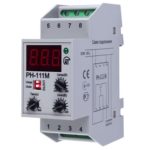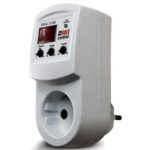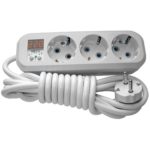Voltage control relays (RCD) installed immediately after the meter and RCD allow to instantly cut off the power supply circuit in the event of an emergency. These devices react to strong fluctuations in the amplitude of the supply voltage and are able to protect consumers connected not only to single-phase, but also to three-phase networks. When installing them, the connection diagram of the voltage relay is of particular importance, which does not allow the slightest deviations from the requirements of the current standards.
ILV types by voltage type
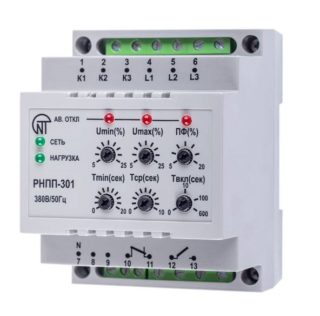
The known samples of voltage control relays primarily differ in the type of power supply, according to which they are divided into single-phase and three-phase models. The first ones are installed in city apartments and are intended to protect loads in linear 220 Volt circuits without re-grounding. Their three-phase counterparts are used in power lines of industrial facilities or in private houses, the owners of which have received permission to connect the corresponding 380 volt equipment. The presence of grounding in this case is considered mandatory.
The three-phase ILV has one significant drawback, which is that when one of the phases is overloaded, it turns off all three lines at once. Some experts consider this property, on the contrary, an advantage, since in this case it is possible to save all the equipment used in this line. It acquires particular importance in production, where a separate load is connected to each of the phase branches. In everyday life, when operating a pump motor, for example, it rather interferes with normal operation. Small voltage fluctuations in one of the phases in this case do not matter much.
ILV varieties by other parameters
In addition to differences in the type of power supply, these devices differ in a number of characteristics that determine the way they are installed, and in functionality.
Execution type and dimensions
In accordance with this feature, all ILV models produced by the industry are divided into three types:
- plug-to-socket adapters;
- extension cords with multiple sockets (one to six);
- compact switches, mounted on a DIN rail in a panel.
The first two versions of products are used to protect individual electrical appliances or several consumers combined into groups. They plug into a regular wall outlet. Devices of the third type are installed in an electrical panel, in which the rest of the protection devices are mounted.
Adapter bodies and extension cords are made quite convenient to use. Manufacturers are trying to reduce their dimensions as much as possible so that they do not spoil the interiors of the premises with their appearance.
DIN-rail mounted devices are more compact in size as no additional tools are required to switch them on. Wires are led to them in the same way as it is done when installing conventional machines or RCDs.
Base and additional functions
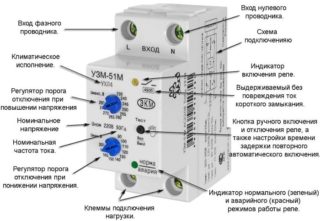
According to the internal logic of work and electronic stuffing, all known ILV samples are divided into microprocessor products and devices based on digital comparators. The first of them are somewhat more expensive, but they provide more accurate and smooth adjustment of the lower and upper response thresholds. Most of these protective devices are microprocessor based and stand out from other products in the following features:
- the presence of two thresholds (Umax and Umin);
- the use of built-in LEDs built into the panel of the device - they control the presence of voltage at the input and output;
- the use of a liquid crystal display, which displays the values of permissible deviations and operating voltage.
All these features significantly increase the functionality of the devices and simplify their work when installed in an apartment or a private house.
ILV connection diagrams
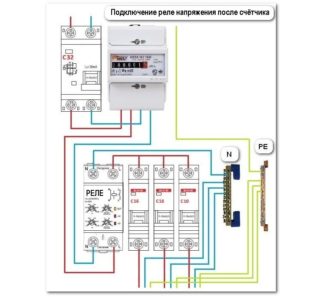
Before connecting the voltage relay, you will need to carefully study the typical circuit of the electrical cabinet. When installing it, a voltage relay must be installed after the electric meter in a break in the phase wire, sometimes an RCD is placed between them, connected as needed. With this arrangement, the surge protection device will cut off exactly the "phase".
For normal operation, phase and ground are applied to its input terminals at the same time.
There are two schemes for connecting single-phase and three-phase relays to the consumption line:
- with direct load through the ILV;
- with consumer connection through a contactor included in the magnetic starter.
In each of these cases, it is possible to connect several devices in parallel, each of which can be connected to its own group of consumers.
When installing electrical panels in an apartment or a private house, a connection scheme with a direct load through the RKN is most often used.
Setting the operating modes
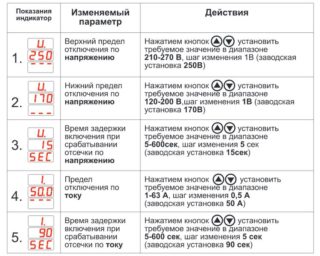
The ILV threshold values are set by means of potentiometers located on the front panel and having a graduated scale.
In some samples of relays, buttons are used for this with displaying parameters on an electronic display.
When the required threshold values are set, their exact values are controlled by the display built into the front panel of the device. After the initial setup for these indicators, there is usually no need to reinstall them.
Which is better: relay or stabilizer
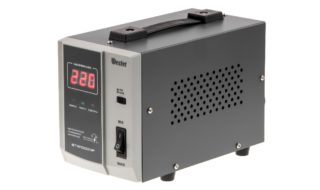
Some users use a typical voltage stabilizer in the house instead of a control relay. In some cases, such a decision is considered justified. However, several nuances were noted that are taken into account when choosing a reliable method for protecting electrical appliances. First of all, you need to keep in mind that they perform similar functions and can disconnect the load in an emergency. But the difference in their work is still there and is manifested in the following:
- stabilizers are distinguished by an increased level of noise and are much more expensive;
- they are more inertial, especially when tracking sudden voltage drops;
- they do not provide for the possibility of adjusting the settings;
- these devices take up significantly more space.
With a decrease in the input signal, the stabilizer begins to consume more current, which is explained by the need to maintain the output voltage at a constant level.
The main disadvantage of the stabilizer in comparison with the RKN is the inability to respond to sudden voltage drops in the network when the neutral wire breaks.
Just a fraction of a second is enough for a voltage surge of 350-380 Volts to burn out all household appliances connected to the sockets. Most of the samples of electronic stabilizers produced by the domestic industry are not capable of responding to short-term pulsations.The characteristics of stationary devices provide for a reaction time not exceeding 1-2 seconds. Therefore, the correct approach to choosing a protection device is a guarantee of the safety of the equipment connected to it.
Features of the voltage relay in three-phase networks

In three-phase circuits, a particular danger is the switching on of the relay with low voltage, the connection diagram of which does not provide for a single-phase operation of the device. In most cases in industrial networks, a separate load is connected to each of the phases. This leads to the fact that the overload operation of one section of the ILV leads to its complete shutdown.
An exception is the situation when the facility mainly uses three-phase equipment (machines with asynchronous motors, pumps, etc.). In this case, each of the phases is loaded more evenly and practically no voltage overload occurs.
Regardless of the type of ILV, for their normal operation, you will need to choose the correct scheme and installation location.

